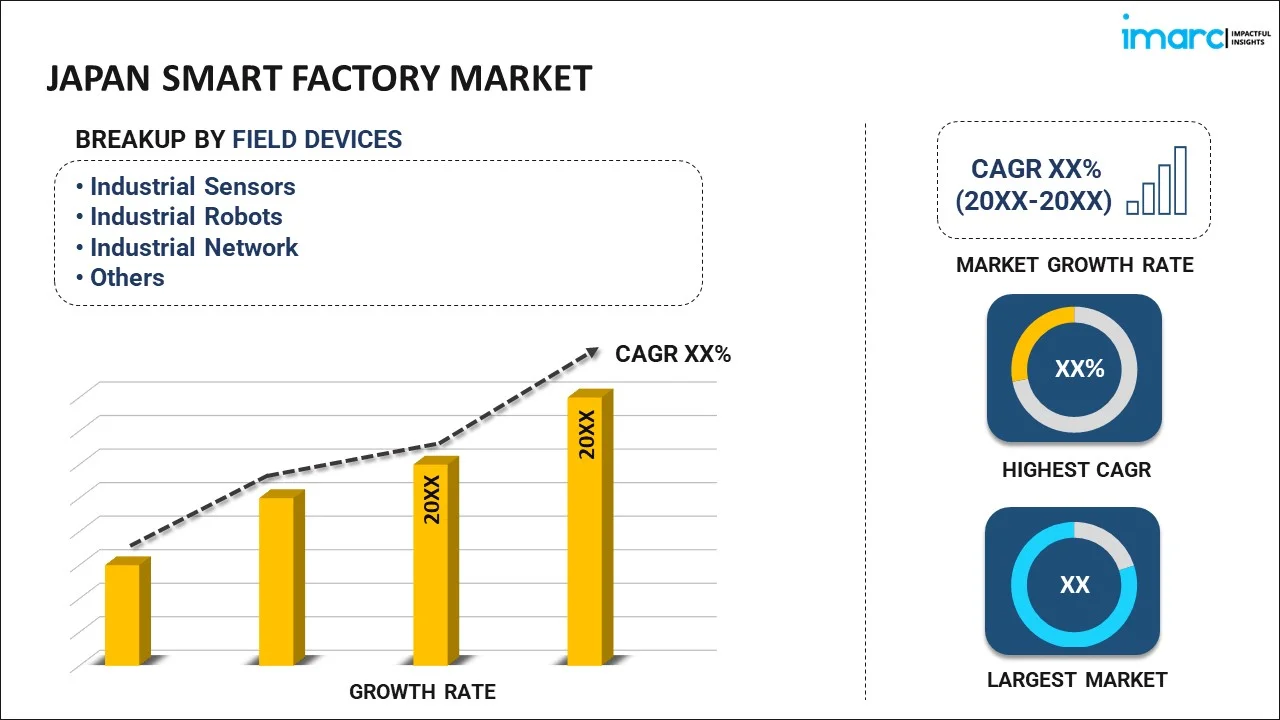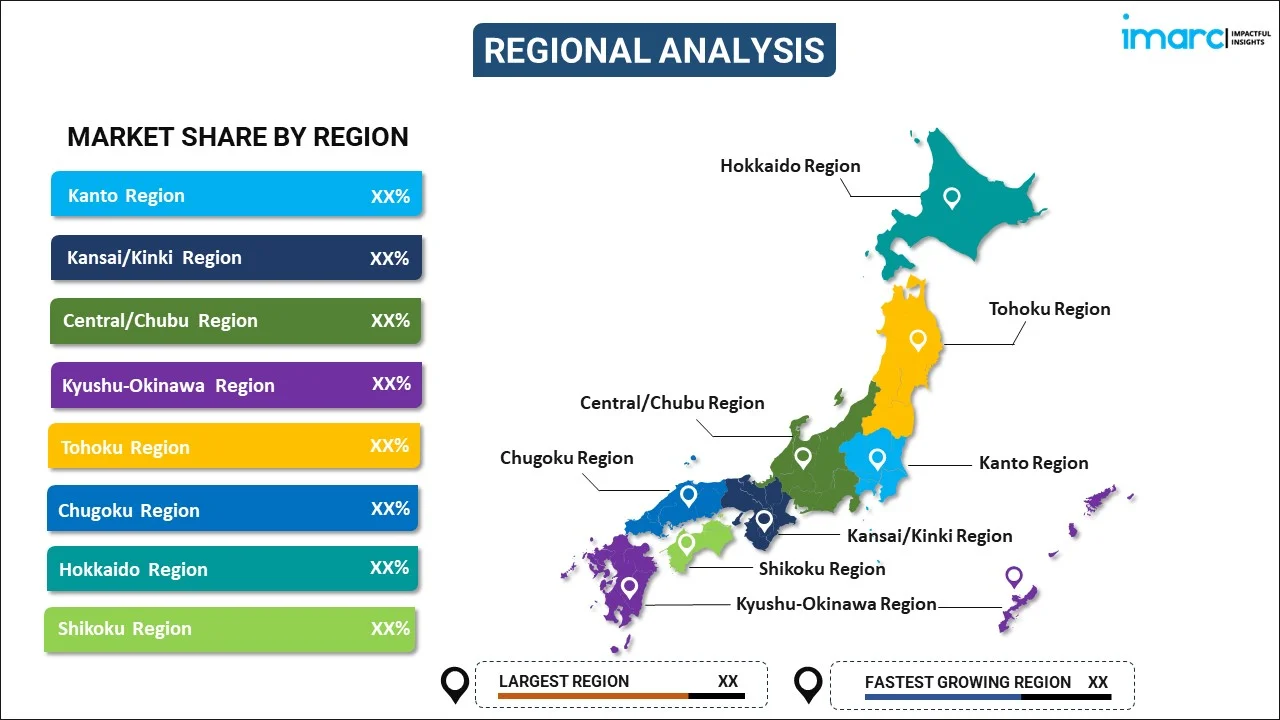
Japan Smart Factory Market Report by Field Devices (Industrial Sensors, Industrial Robots, Industrial Network, Industrial 3D Printers, Machine Vision Systems), Technology (Product Lifecycle Management (PLM), Human Machine Interface (HMI), Enterprise Resource Planning (ERP), Manufacturing Execution Systems (MES), Distributed Control Systems (DCS), Industrial Control System, and Others), End Use Industry (Pharmaceuticals, Food and Beverages, Chemical, Oil and Gas, Automotive and Transportation, Semiconductor and Electronics, Aerospace and Defense, and Others), and Region 2025-2033
Market Overview:
Japan smart factory market size reached USD 3.8 Billion in 2024. Looking forward, IMARC Group expects the market to reach USD 8.7 Billion by 2033, exhibiting a growth rate (CAGR) of 9.5% during 2025-2033. The rising usage of refurbished industrial robots, along with the elevating integration of connected devices with cloud computing, is primarily driving the market growth.
|
Report Attribute
|
Key Statistics
|
|---|---|
|
Base Year
|
2024 |
|
Forecast Years
|
2025-2033 |
|
Historical Years
|
2019-2024
|
| Market Size in 2024 | USD 3.8 Billion |
| Market Forecast in 2033 | USD 8.7 Billion |
| Market Growth Rate (2025-2033) | 9.5% |
A smart factory represents a state-of-the-art manufacturing facility that deploys cutting-edge technologies and automation systems to enhance production processes, elevate efficiency, and optimize overall operational performance. It harnesses advanced innovations such as the Internet of Things (IoT), artificial intelligence (AI), robotics, data analytics, and cloud computing to establish a highly interconnected and intelligent manufacturing ecosystem. Within a smart factory, machinery and equipment are outfitted with sensors and linked to a central network, facilitating real-time data collection and analysis. This capability enables predictive maintenance, early detection of issues, and proactive decision-making to minimize downtime and enhance productivity. The advantages of smart factories are manifold and encompass increased productivity, cost reduction, enhanced product quality, improved worker safety, and heightened adaptability in responding to market demands.
Japan Smart Factory Market Trends:
In the Japan smart factory market, one of the primary driving forces is the increasing demand for industrial automation, coupled with the rapid pace of digitization. Furthermore, the market's positive outlook is shaped by a growing emphasis on energy conservation and enhanced manufacturing efficiency. Additionally, the widespread adoption of manufacturing execution systems (MES) and advanced data models tailored for process-specific operations is exerting a positive influence on market expansion. Alongside this trend, there is a noticeable increase in the utilization of reconditioned industrial robots and radio frequency identification (RFID) systems, which is acting as another significant growth-inducing factor. Concurrently, various technological advancements, including the seamless integration of connected devices with cloud computing, the Internet of Things (IoT), and artificial intelligence (AI), are fostering a favorable market landscape. Moreover, the introduction of the Industrial Internet of Things (IIoT), the increasing implementation of smart factory solutions, and the growing embrace of sustainable manufacturing practices are presenting attractive growth opportunities for key industry players. This, in turn, is expected to propel the market growth in Japan over the forecasted period.
Japan Smart Factory Market Segmentation:
IMARC Group provides an analysis of the key trends in each segment of the market, along with forecasts at the country level for 2025-2033. Our report has categorized the market based on field devices, technology, and end use industry.
Field Devices Insights:

- Industrial Sensors
- Industrial Robots
- Industrial Network
- Industrial 3D Printers
- Machine Vision Systems
The report has provided a detailed breakup and analysis of the market based on the field devices. This includes Industrial sensors, industrial robots, industrial network, industrial 3D printers and machine vision systems.
Technology Insights:
- Product Lifecycle Management (PLM)
- Human Machine Interface (HMI)
- Enterprise Resource Planning (ERP)
- Manufacturing Execution Systems (MES)
- Distributed Control Systems (DCS)
- Industrial Control System
- Others
A detailed breakup and analysis of the market based on the technology have also been provided in the report. This includes product lifecycle management (PLM), human machine interface (HMI), enterprise resource planning (ERP), manufacturing execution systems (MES), distributed control systems (DCS), industrial control system and others.
End Use Industry Insights:
- Pharmaceuticals
- Food and Beverages
- Chemical
- Oil and Gas
- Automotive and Transportation
- Semiconductor and Electronics
- Aerospace and Defense
- Others
The report has provided a detailed breakup and analysis of the market based on the end use industry. This includes pharmaceuticals, food and beverages, chemical, oil and gas, automotive and transportation, semiconductor and electronics, aerospace and defense and others.
Regional Insights:

- Kanto Region
- Kansai/Kinki Region
- Central/ Chubu Region
- Kyushu-Okinawa Region
- Tohoku Region
- Chugoku Region
- Hokkaido Region
- Shikoku Region
The report has also provided a comprehensive analysis of all the major regional markets, which include Kanto Region, Kansai/Kinki Region, Central/ Chubu Region, Kyushu-Okinawa Region, Tohoku Region, Chugoku Region, Hokkaido Region, and Shikoku Region.
Competitive Landscape:
The market research report has also provided a comprehensive analysis of the competitive landscape. Competitive analysis such as market structure, key player positioning, top winning strategies, competitive dashboard, and company evaluation quadrant has been covered in the report. Also, detailed profiles of all major companies have been provided.
Japan Smart Factory Market Report Coverage:
| Report Features | Details |
|---|---|
| Base Year of the Analysis | 2024 |
| Historical Period | 2019-2024 |
| Forecast Period | 2025-2033 |
| Units | Billion USD |
| Scope of the Report | Exploration of Historical Trends and Market Outlook, Industry Catalysts and Challenges, Segment-Wise Historical and Future Market Assessment:
|
| Field Devices Covered | Industrial Sensors, Industrial Robots, Industrial Network, Industrial 3D Printers, Machine Vision Systems |
| Technologies Covered | Product Lifecycle Management (PLM), Human Machine Interface (HMI), Enterprise Resource Planning (ERP), Manufacturing Execution Systems (MES), Distributed Control Systems (DCS), Industrial Control System, Others |
| End Use Industries Covered | Pharmaceuticals, Food and Beverages, Chemical, Oil and Gas, Automotive and Transportation, Semiconductor and Electronics, Aerospace and Defense, Others |
| Regions Covered | Kanto Region, Kansai/Kinki Region, Central/ Chubu Region, Kyushu-Okinawa Region, Tohoku Region, Chugoku Region, Hokkaido Region, Shikoku Region |
| Customization Scope | 10% Free Customization |
| Post-Sale Analyst Support | 10-12 Weeks |
| Delivery Format | PDF and Excel through Email (We can also provide the editable version of the report in PPT/Word format on special request) |
Key Questions Answered in This Report:
- How has the Japan smart factory market performed so far and how will it perform in the coming years?
- What has been the impact of COVID-19 on the Japan smart factory market?
- What is the breakup of the Japan smart factory market on the basis of field devices?
- What is the breakup of the Japan smart factory market on the basis of technology?
- What is the breakup of the Japan smart factory market on the basis of end use industry?
- What are the various stages in the value chain of the Japan smart factory market?
- What are the key driving factors and challenges in the Japan smart factory?
- What is the structure of the Japan smart factory market and who are the key players?
- What is the degree of competition in the Japan smart factory market?
Key Benefits for Stakeholders:
- IMARC’s industry report offers a comprehensive quantitative analysis of various market segments, historical and current market trends, market forecasts, and dynamics of the Japan smart factory market from 2019-2033.
- The research report provides the latest information on the market drivers, challenges, and opportunities in the Japan smart factory market.
- Porter's five forces analysis assist stakeholders in assessing the impact of new entrants, competitive rivalry, supplier power, buyer power, and the threat of substitution. It helps stakeholders to analyze the level of competition within the Japan smart factory industry and its attractiveness.
- Competitive landscape allows stakeholders to understand their competitive environment and provides an insight into the current positions of key players in the market.
Need more help?
- Speak to our experienced analysts for insights on the current market scenarios.
- Include additional segments and countries to customize the report as per your requirement.
- Gain an unparalleled competitive advantage in your domain by understanding how to utilize the report and positively impacting your operations and revenue.
- For further assistance, please connect with our analysts.
 Inquire Before Buying
Inquire Before Buying
 Speak to an Analyst
Speak to an Analyst
 Request Brochure
Request Brochure
 Request Customization
Request Customization




.webp)




.webp)












